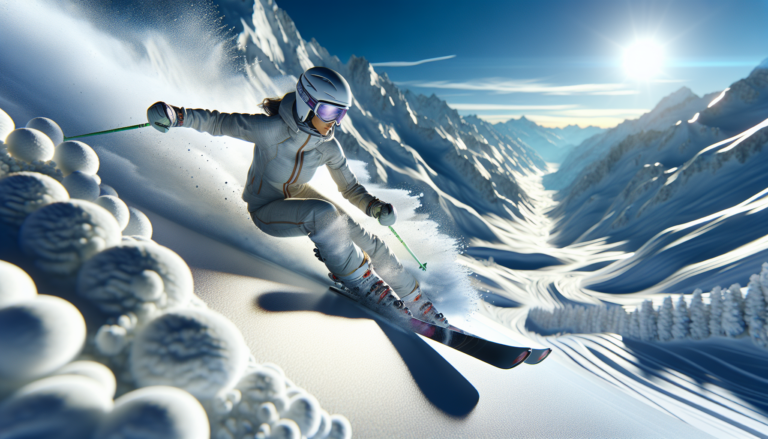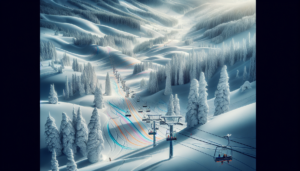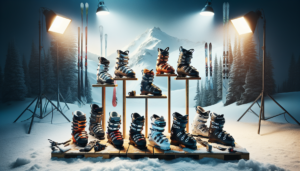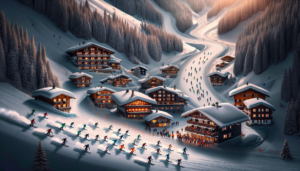Introduction to Mogul Skiing
Mogul skiing is an exhilarating and challenging aspect of downhill skiing that involves navigating a series of bumps, or moguls, on a ski run. These moguls are formed by skiers making turns down the slope, creating a unique and dynamic terrain that requires specific techniques to master. For many skiers, the thrill of conquering moguls is a major draw to the sport.
What Are Moguls?
Moguls are mounds of hardened snow that form naturally on a ski slope as skiers make turns down the hill. They typically appear as evenly spaced bumps arranged in a pattern down the fall line of the slope. Moguls present a unique challenge for skiers, requiring quick adjustments, precise timing, and solid technique to navigate smoothly.
The size and shape of moguls can vary depending on factors such as the steepness of the slope, the amount of traffic it receives, and the type of snow. Mogul runs are often marked with a black diamond rating, indicating their difficulty level.
Why Ski Moguls?
While mogul skiing can be intimidating for beginners, it offers numerous benefits and rewards for those willing to take on the challenge. Skiing moguls helps improve overall technique, balance, and control on skis. The constant adjustments required to navigate the bumps force skiers to hone their skills and develop quick reflexes.
Additionally, mogul skiing provides an excellent workout, engaging the leg muscles, core, and cardiovascular system. The physical demands of mogul skiing can help build strength and endurance over time.
Perhaps most importantly, successfully skiing a mogul run delivers an incredible sense of accomplishment and exhilaration. Conquering a challenging mogul field is a thrilling experience that keeps many skiers coming back for more.
Essential Techniques for Skiing Moguls
To successfully navigate moguls, skiers must employ specific techniques that differ from those used on groomed runs. These techniques involve maintaining balance, managing weight distribution, and using strategic movements to control speed and direction.
Maintaining Balance and Control
One of the key aspects of mogul skiing is maintaining balance and control throughout the run. This requires keeping the upper body stable and quiet while the legs absorb the impact of the bumps. Skiers should focus on keeping their arms forward and their hands in front of their body, using pole plants to aid in balance and rhythm.
Knee and ankle flexion is also crucial for absorbing the shock of the moguls and maintaining control. Skiers should strive to keep their knees bent and their shins pressed against the front of their boots throughout the run.
Weight Distribution and Pole Plants
Proper weight distribution is essential for successfully navigating moguls. Skiers should aim to keep their weight centered over the middle of their skis, avoiding leaning too far back or forward. This allows for better control and quicker adjustments as needed.
Pole plants play an important role in maintaining rhythm and balance while skiing moguls. Skiers should plant their poles at the top of each mogul, using the pole plant to initiate the turn and stay in sync with the bump pattern.
| Technique | Description |
|---|---|
| Maintain stable upper body | Keep arms forward and hands in front, using pole plants for balance and rhythm |
| Knee and ankle flexion | Bend knees and press shins against boots to absorb shock and maintain control |
| Center weight over skis | Avoid leaning too far forward or back for better control and quicker adjustments |
| Pole plant at top of mogul | Use pole plant to initiate turns and stay in sync with bump pattern |
Choosing Your Line
When approaching a mogul field, skiers must choose a line, or path, through the bumps. The ideal line depends on factors such as the size and spacing of the moguls, the skier’s skill level, and the desired speed.
Beginners may opt for a line that goes over the top of the moguls, allowing for slower speeds and more time to make turns. More advanced skiers may choose a line that weaves around the sides of the moguls, enabling higher speeds and quicker turns.
Regardless of the chosen line, skiers should always be looking ahead to anticipate the next few moguls. This allows for better planning and smoother adjustments as the skier progresses down the run.
Equipment for Mogul Skiing
Having the right equipment is important for successfully skiing moguls. Skis and boots that are well-suited for mogul skiing can make a significant difference in performance and enjoyment on the hill.
Selecting the Right Skis
When choosing skis for mogul skiing, there are a few key factors to consider. Mogul skis are typically shorter and narrower than all-mountain or powder skis, allowing for quicker turns and easier maneuverability in tight spaces. Skis with a softer flex pattern can also be beneficial, as they allow for better absorption of the bumps.
Many ski brands offer specific mogul skis designed for optimal performance in bumpy terrain. Examples include:
- Völkl Mogul Skis
- K2 Mogul Skis
- Rossignol Mogul Skis
Importance of Proper Ski Boots
Ski boots are another crucial piece of equipment for mogul skiing. Boots that are too soft or too stiff can hinder performance and control in the bumps. Mogul skiers generally prefer boots with a medium to stiff flex pattern, which allows for better responsiveness and power transfer to the skis.
Proper boot fit is also essential. Boots should be snug and secure, with minimal heel lift and room for toes to wiggle slightly. A well-fitted boot helps ensure precise control and efficient energy transfer while skiing moguls.
Physical and Mental Preparation
Mogul skiing is physically and mentally demanding, requiring strength, endurance, and focus. Proper preparation in both areas can greatly enhance performance and enjoyment on the hill.
Building Leg Strength and Endurance
The constant absorption of bumps and quick turns involved in mogul skiing puts significant strain on the leg muscles, particularly the quads, hamstrings, and calves. Building strength and endurance in these muscle groups is crucial for maintaining proper technique and avoiding fatigue.
Off-snow exercises such as squats, lunges, and plyometric jumps can help develop the necessary leg strength for mogul skiing. Endurance can be improved through activities like cycling, running, and stair climbing.
Mental Strategies for Success
In addition to physical preparation, having the right mental approach is key to success in mogul skiing. Skiers must stay focused, confident, and adaptable to the constantly changing terrain.
Some helpful mental strategies include:
- Visualizing a successful run before starting
- Breaking the run into smaller sections and focusing on one mogul at a time
- Maintaining a positive attitude and embracing the challenge
- Learning from mistakes and adjusting technique as needed
Advanced Tips for Mastering Moguls
As skiers progress in their mogul skiing abilities, they can start to incorporate more advanced techniques and strategies to take their skills to the next level.
Developing Rhythm and Timing
One of the hallmarks of expert mogul skiing is a smooth, fluid rhythm throughout the run. This involves synchronizing turns with the shape and spacing of the moguls, using a consistent tempo and avoiding abrupt movements.
To develop rhythm and timing, skiers can focus on:
- Counting turns to maintain a steady cadence
- Anticipating transitions between moguls
- Using pole plants as a metronome to stay in sync
Adapting to Different Snow Conditions
Mogul fields can present a variety of snow conditions, from soft, forgiving bumps to icy, unforgiving ones. Advanced mogul skiers must be able to adapt their technique to the current conditions for optimal performance and safety.
In softer snow, skiers may opt for a more direct line over the tops of the moguls, allowing the skis to sink in and absorb the terrain. On icier moguls, a line that avoids the tops and seeks out softer snow on the sides may be preferable.
Fresh snowfall can also present unique challenges, as the added depth and inconsistency can obscure the underlying mogul pattern. In these conditions, skiers must be extra alert and ready to adapt to unexpected terrain changes.
Learning from the Experts
One of the best ways to improve mogul skiing skills is to learn from those who have already mastered the technique. Expert mogul skiers, both professional and recreational, can provide valuable insights and inspiration for skiers of all levels.
Following Professional Skiers
Professional mogul skiers, also known as “bumpers,” compete in freestyle skiing events around the world. Watching these athletes navigate mogul courses with speed, precision, and style can be a great way to pick up new techniques and strategies.
Some notable professional mogul skiers to follow include:
- Mikaël Kingsbury (Canada)
- Jaelin Kauf (USA)
- Justine Dufour-Lapointe (Canada)
- Brad Wilson (USA)
Utilizing Online Tutorials and Resources
In addition to following professional skiers, there are numerous online resources available for skiers looking to improve their mogul skills. Websites, forums, and social media groups dedicated to mogul skiing offer a wealth of information and advice from experienced skiers.
Instructional videos and tutorials can be particularly helpful for visualizing proper technique and identifying areas for improvement. The “How to Ski Bumps” tutorial series by Avoriaz Alpine Ski School is a popular resource that breaks down mogul skiing techniques in an easy-to-follow format.
Conclusion
Mogul skiing is a challenging and rewarding discipline that offers endless opportunities for growth and improvement. By developing solid techniques, utilizing proper equipment, and maintaining physical and mental fitness, skiers can learn to conquer even the most daunting mogul fields.
Recap of Key Points
– Mogul skiing requires specific techniques for maintaining balance, managing weight distribution, and controlling speed and direction
– Proper equipment, including skis and boots suited for moguls, is crucial for performance and safety
– Physical conditioning and mental preparation are key components of successful mogul skiing
– Advanced techniques like rhythm and timing can help take mogul skills to the next level
– Learning from expert skiers and utilizing online resources can accelerate progress and improvement
Encouragement for Practice and Progression
Mogul skiing is a journey that rewards dedication, patience, and a willingness to learn. Embrace the challenges, celebrate the triumphs, and never stop striving for improvement.
Remember that every skier, even the most advanced, started as a beginner. With practice, persistence, and a positive attitude, anyone can become a confident and capable mogul skier.
So get out there, challenge yourself, and most importantly, have fun! The exhilaration of mastering a mogul run is an experience like no other, and the journey to get there is just as rewarding as the destination.






